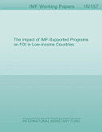Income Polarization in the United States
Jun 2016 · International Monetary Fund
eBook
36
Halaman
reportRating dan ulasan tidak diverifikasi Pelajari Lebih Lanjut
Tentang eBook ini
The paper uses a combination of micro-level datasets to document the rise of income polarization—what some have referred to as the “hollowing out” of the income distribution—in the United States, since the 1970s. While in the initial decades more middle-income households moved up, rather than down, the income ladder, since the turn of the current century, most of polarization has been towards lower incomes. This result is striking and in contrast with findings of other recent contributions. In addition, the paper finds evidence that, after conditioning on income and household characteristics, the marginal propensity to consume from permanent changes in income has somewhat fallen in recent years. We assess the potential impacts of these trends on private consumption. During 1998-2013, the rise in income polarization and lower marginal propensity to consume have suppressed the level of real consumption at the aggregate level, by about 31⁄2 percent—equivalent to more than one year of consumption.
Beri rating eBook ini
Sampaikan pendapat Anda.
Informasi bacaan
Smartphone dan tablet
Instal aplikasi Google Play Buku untuk Android dan iPad/iPhone. Aplikasi akan disinkronkan secara otomatis dengan akun Anda dan dapat diakses secara online maupun offline di mana saja.
Laptop dan komputer
Anda dapat mendengarkan buku audio yang dibeli di Google Play menggunakan browser web komputer.
eReader dan perangkat lainnya
Untuk membaca di perangkat e-ink seperti Kobo eReaders, Anda perlu mendownload file dan mentransfernya ke perangkat Anda. Ikuti petunjuk Pusat bantuan yang mendetail untuk mentransfer file ke eReaders yang didukung.






